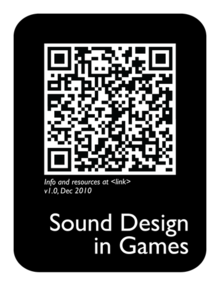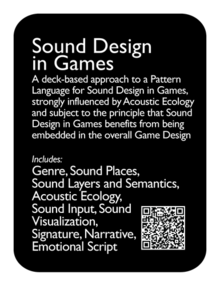Difference between revisions of "Sound Design in Games"
From SoundInGames.com - Sound Design in Games
ValterAlves (Talk | contribs) |
ValterAlves (Talk | contribs) |
||
| Line 9: | Line 9: | ||
It differs from other cards in the deck in the sense that it was not designed with the goal of representing specific sound design explorations. It rather supports the communication of [[the overall mindset]] for which every card is subject.<br /><br /> | It differs from other cards in the deck in the sense that it was not designed with the goal of representing specific sound design explorations. It rather supports the communication of [[the overall mindset]] for which every card is subject.<br /><br /> | ||
The card is also used to contextualize other cards that carry high level concepts or that are transversal to the sound design, as illustrated by the relationships field. | The card is also used to contextualize other cards that carry high level concepts or that are transversal to the sound design, as illustrated by the relationships field. | ||
| + | |||
| + | One important role of this card is to make clear that there is more information available besides the limited contents of the card. The front face includes a bloated [[QR-Code]] that is meant to emphasize that aspect. It is important to notice that we are not arguing that the cards ''should'' be used in while accessing extended information. Actually, our major design goal when designing the front face of this particular card was to to establish a clear idea that the cards are, by design, a partial view of the information they address. Still, we argue the usage of cards (subject to that mindset) is meaningful even without access to the respective extended information, either because they may communicate information enough to support design decisions, or because users are already fairly familiar with the extended contents and are able to appreciate the usefulness of short tokens to the respective ideas. | ||
For most effects this card is not considered when counting the number of cards in the deck, which is said to be [[Deck-v-1-0|68]]. This may be regarded as the 69<sup>th</sup> card – or the ''0<sup>th</sup>'', to be more coherent with its purpose. | For most effects this card is not considered when counting the number of cards in the deck, which is said to be [[Deck-v-1-0|68]]. This may be regarded as the 69<sup>th</sup> card – or the ''0<sup>th</sup>'', to be more coherent with its purpose. | ||
Revision as of 14:49, 26 June 2011

|

| |
| The card's front face | The card's back face |
Contents
[hide]Synopsis
| A deck-based approach to a Pattern Language for Sound. |
Relationships
Includes:
Genre File:M385px-Genre-front-v20.png, Sound Places File:M385px-SoundPlaces-front-v20.png, Sound Layers and Semantics File:M385px-SoundLayersAndSemantics-front-v20.png, Acoustic Ecology ![]() , Sound Input
, Sound Input ![]() , Sound File:M385px-Sound-front-v20.png.
, Sound File:M385px-Sound-front-v20.png.
Description
Examples